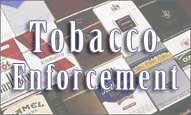 November 23, 2008 - Exactly 10 years ago on November 23, 1998, 46 states settled their lawsuits against the nation’s major tobacco companies to recover tobacco-related health care costs, joining four states — Mississippi, Texas, Florida and Minnesota — that had reached earlier, individual settlements. The tobacco companies agreed to a $246 billion settlement to be paid to the states over 25 years.
November 23, 2008 - Exactly 10 years ago on November 23, 1998, 46 states settled their lawsuits against the nation’s major tobacco companies to recover tobacco-related health care costs, joining four states — Mississippi, Texas, Florida and Minnesota — that had reached earlier, individual settlements. The tobacco companies agreed to a $246 billion settlement to be paid to the states over 25 years.
The states have failed to keep their promise to spend a significant portion of the money on programs to protect kids from tobacco and help smokers quit, according to a report released today by a coalition of public health organizations (see reference below). What happened to the money? States have spent less than 5 percent of their settlement proceeds on tobacco control. Many have used the money to help balance budgets, build schools and pave roads. The few that have invested more heavily in anti-smoking programs have lowered their smoking rates. (Over the past decade, the states have received $203.5 billion in tobacco-generated revenue, but they have spent only $6.5 billion on tobacco prevention and cessation programs. Only nine states are funding tobacco prevention at even half the CDC-recommended amount, and 27 states are providing less than a quarter of the recommended funding.)
Smoking rates are down. Twenty percent (from 36 percent) of high school students and 19.7 percent (from 25 percent) of adults still smoke, and tobacco use remains the nation's leading cause of preventable death.
Some states have borrowed against future payments from the tobacco industry, as a result they are now dependent on the continued vitality of cigarette sales. If Big Tobacco stumbles, states will be on the hook for these massive, billion-dollar loans. (Ten years later, tobacco deal going up in smoke by Bob Sullivan, RedTape.MSBNC.com, 11/21/2008)
Cigarette makers now do much more target advertising, using elaborate databases, direct mail and point-of-sale at convenience stores and adult-only venues like bars.
The tobacco industry continues to aggressively market its products. The tobacco companies spend nearly $19 to market tobacco products for every $1 the states spend to prevent kids from smoking and help smokers quit.
The report from the coalition of public health organizations (see reference below) calls on Congress and the states to follow the recommendations of recent landmark reports by the Institute of Medicine and the President's Cancer Panel, including enacting legislation granting the U.S. Food and Drug Administration authority to regulate the manufacturing, marketing and sale of tobacco products. Additionally, the states should further increase tobacco taxes, enact comprehensive smoke-free workplace laws and fund tobacco prevention programs at CDC-recommended levels.
On 10th Anniversary of 1998 Tobacco Settlement, Report Finds Most States Fail To Adequately Fund Tobacco Prevention Programs, Issued by the Campaign for Tobacco-Free Kids, American Heart Association, American Cancer Society Cancer Action Network, American Lung Association and Robert Wood Johnson Foundation, 11/18/2008.
Some related news briefs: Youth exposed to smokeless tobacco ads despite settlement…; April 2007 issue of Glamour had a 2-page Camel No. 9 ad on a thicker single page (front and back) in the center of the magazine..; Tobacco ads now even appears in PC Magazine (June 5, 2007).. and Camel by R.J. Reynolds Tobacco has a new...
Bringing the World of Tobacco Control closer together..
Ten Yrs Later the 1998 State Tobacco Master Settlement Agreement (MST)..
Subscribe to:
Post Comments (Atom)


To Provide Public Awareness
Purpose
About Us
Contact Us
2008 HIGHLIGHTS
TOPIX PAPERS - 2008 & 2009..
Archive
-
▼
2008 (578)
-
▼
11/23 - 11/30 (12)
- SNUS Ewa Björling, Sweden's trade minister more co...
- Cigarettes “fire safe” in Minnesota as of December...
- Canada - Police arrest 46 in tobacco crackdown..
- Jakarta, Indonesia - Malls help enforce non-smokin...
- India - placing pictorial warnings on tobacco prod...
- Don't patronize places where people are smoking..
- Indonesia - federal anti-smoking laws in one year ...
- West Virginia another Camel SNUS test market..
- WHO FCTC Durbin Meeting (Nov 17-22, 2008) - Gene...
- Teens, Smoking Parents - Greatest Risk of Smoking..
- Ten Yrs Later the 1998 State Tobacco Master Settle...
- Kentucky considering increase in cigarette tax..
-
▼
11/23 - 11/30 (12)
© Copyright Notice: The content of this website is for information education purposes only and any newsbrief may be used only as "fair use" for information/education purposes with permission of the authors and providing that original references and associated reference links are included in HTML format.
0 comments:
Post a Comment